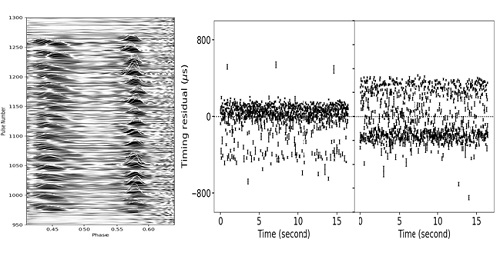Detecting nanohertz gravitational waves using pulsar timing arrays (PTAs) is one of the key science goals of radio astronomy. Understanding noises in the PTA data is crucial for improving timing precision required for detecting nanohertz gravitational waves.
Recently, the research team, led by Mr. Yi Feng and his supervisors Prof. Di Li and Dr. George Hobbs from The Commonwealth Scientific and Industrial Research Organization (CSIRO), has found jitter noise mode in a millisecond pulsar, namely PSR J1022+1001, which has been regularly monitored by PTAs. This represents the initial step of understanding jitter noise of PTA millisecond pulsars with FAST and demonstrates the FAST's potential to improve PTA performance.
The paper has recently been published in The Astrophysical Journal.

Figure 1: Detecting nanohertz gravitational waves using pulsar timing array: gravitational waves sweeping over the pulsar or the Earth introduce fluctuations in pulse times of arrival. (Credit: Champion D)

Figure 2: Left: Single-pulse train with jitter noise caused profile and phase of variation. (Credit: Pei Wang) Right: The first 1000 timing residuals of J1022+1001 using different templates. In the left-hand panel the standard template is used. In the right-hand panel a template obtained from the summation of the profiles that formed the most negative timing residuals in the left-hand panel is used. (Credit: Feng et al.)
Currently, three international PTAs (PPTA, EPTA, and NANOGrav) have been operating for more than ten years and are expected to detect nanohertz gravitational waves in the coming years. With FAST data, Feng et al. analyzed single pulses of PSR J1022+1001 and found jitter noise mode in millisecond pulsars for the first time. As is shown in Figure 1, the timing residuals of single pulses of PSR J1022+1001 are separated, and this shows that there are modes in jitter noise.
Further characterizing such behavior may improve timing precision of PTAs and enhance the prospect of detection. As the most sensitive single dish radio telescope in the world, FAST is becoming the corner-stone of the now operating Chinese PTA (CPTA).
This paper is available at https://iopscience.iop.org/article/10.3847/1538-4357/abd326.

Address: 20A Datun Road, Chaoyang District, Beijing, China code: 100012
Tel: 010-64888708 E-mail: naoc@nao.cas.cn

